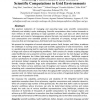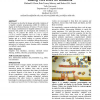1492 search results - page 58 / 299 » Accessibility and computer science education |
CHI
2007
ACM
15 years 11 months ago
2007
ACM
The capability to support spatial perception plays an important role in developing material for astronomy education. Considering this, we developed a novel tangible user interface...
105
click to vote
CORR
2008
Springer
14 years 11 months ago
2008
Springer
The practical realization of managing and executing large scale scientific computations efficiently and reliably is quite challenging. Scientific computations often invo...
96
Voted
NGC
2007
Springer
14 years 10 months ago
2007
Springer
Abstract Understanding potential genetic factors in disease or development of personalised e-Health solutions require scientists to access a multitude of data and compute resources...
ACMIDC
2008
15 years 1 months ago
2008
In this paper we describe the design and initial evaluation of a tangible computer programming exhibit for children on display at the Boston Museum of Science. We also discuss fiv...
CHI
2006
ACM
15 years 11 months ago
2006
ACM
`Embedded phenomena' is a learning technology framework in which simulated scientific phenomena are mapped onto the physical space of classrooms. Students monitor and control...



